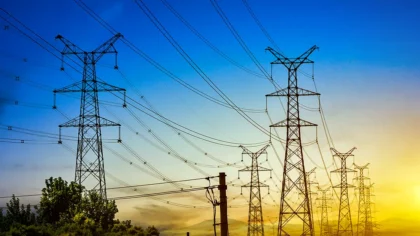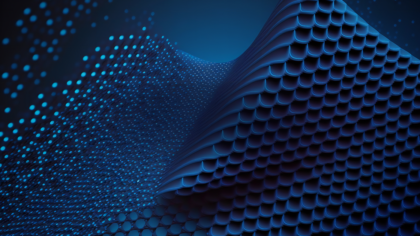Accelerate Productivity in 2025
Reignite Growth Despite the Global Slowdown
The growing need for automation, predictive analysis, and real-time site monitoring drives the rapid adoption of AI in the construction industry. Reflecting this, the AI market in construction is projected to grow from USD 4.86 billion in 2025 to USD 22.68 billion by 2032 with a compound annual growth rate (CAGR) of 24.6%.
This strategic guide explores 10 key areas where you can implement AI in your construction company and optimize project design, management, and execution. Further, you will explore practical insights, popular AI applications in construction, and emerging startups to stay ahead of the curve.
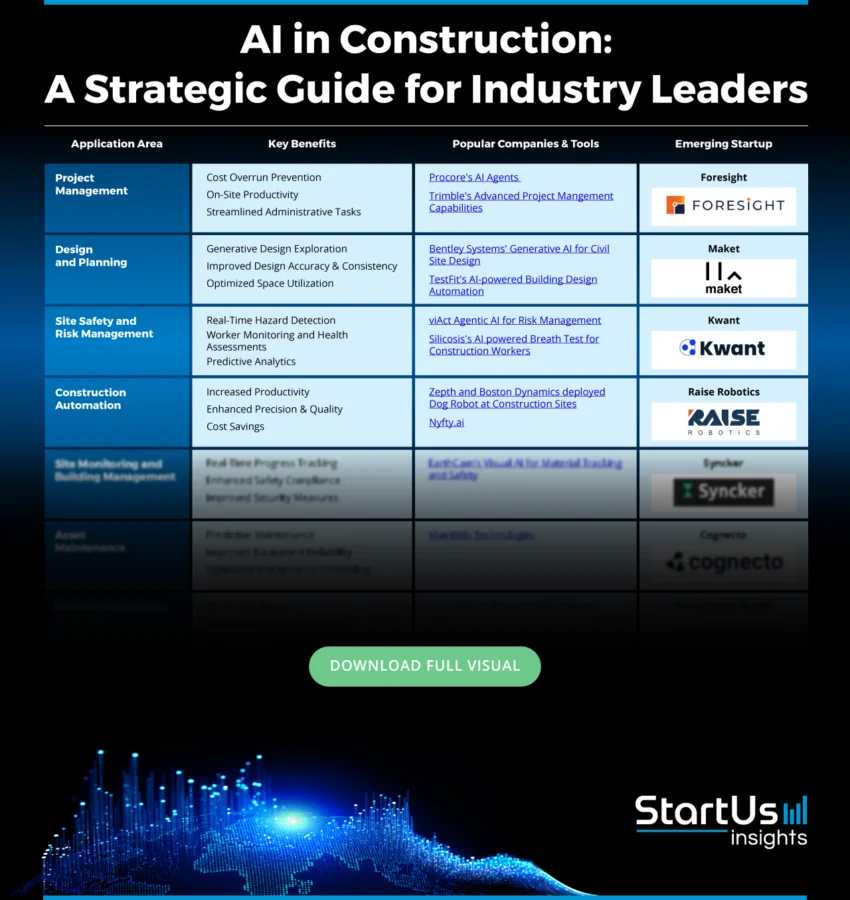
Executive Summary
- AI Adoption – Outlook and Economic Impact: By 2025, AI adoption in construction will significantly grow worldwide, with substantial market expansion and proven efficiency in cost estimation.
- 10 Key Areas to Implement AI in the Construction Industry:
- Key Drivers: AI adoption in construction is driven by significant efficiency gains, enhanced safety measures, and substantial cost savings.
- Future Outlook of AI in Construction: Emerging AI trends in construction include automated design-to-build workflows, swarm robots, generative AI, and self-learning digital twins.
How Do We Research and Where is This Data From?
We reviewed 3100+ industry innovation reports to extract key insights and construct a comprehensive guide for integrating AI in construction workflows. To increase accuracy, we cross-validated this information with external industry sources.
Additionally, we leveraged the StartUs Insights Discovery Platform – our AI and Big Data-powered innovation intelligence tool covering over 7M startups and more than 20K technologies & trends worldwide to:
- Confirm our findings using the Trend Intelligence feature.
- Gather market statistics for each technology.
- Identify startups for the “Spotlighting an Innovator” sections.
Current Outlook on the Adoption and Economic Impact of AI in Construction
- Adoption Trends: 72% of tech companies are already using AI agents, but other industries like construction are slowing in adoption due to a lack of knowledge and internal conflict.
- Cost-Effectiveness Ratio (CER) – AI achieves up to 97% accuracy in cost estimations compared to traditional methods and reduces errors while improving resource allocation.
- Market Size: The AI market in construction is anticipated to reach USD 7.21 billion by 2029 with a CAGR of 33.2%. North America leads the market, with the US market size expected to reach USD 7.21 billion by 2034.
How to Use AI in Construction: 10 Key Areas for Implementation [2025 & Beyond]
You may also like:
1. Project Management
The integration of AI in project management enables construction companies to deliver projects faster within budget and with fewer risks. For instance, AI-powered platforms analyze historical project data, workforce productivity, weather forecasts, material delivery logs, and even subcontractor performance to predict potential delays and cost overruns.
Computer vision systems further leverage cameras and drones to monitor job sites and compare real-time footage to BIM models and schedules. Buildots, for example, uses helmet-mounted cameras and AI to compare captured imagery with BIM models to identify construction errors.
Moreover, companies are utilizing intelligent cost estimation tools, such as Procore Construction Intelligence and Autodesk Construction IQ, to generate accurate budget forecasts.
Modern AI platforms also streamline collaborations by creating centralized dashboards that synthesize project health indicators, risk alerts, and actionable insights. Autodesk Construction IQ assigns risk scores based on safety trends and subcontractor behaviors.
Key Benefits
- Cost Overrun Prevention: AI algorithms analyze historical project data and real-time inputs for contractors to forecast budget deviations early.
- On-Site Productivity: Computer vision and machine learning track worker movements, equipment usage, and material flow to detect inefficiencies and suggest optimizations.
- Streamlined Administrative Tasks: AI automates routine documentation, request for information (RFI) management, and scheduling to reduce manual workload and minimize delays.
Popular Companies and Tools
Procore’s AI Agents
Procore offers AI agents to automate time-consuming coordination tasks across schedules, documents, and RFIs. Integrated into its cloud-based platform, the AI proactively identifies blockers, tracks project milestones, and suggests next steps to keep teams aligned, functioning as collaborative assistants.
Trimble’s ProjectSight
Trimble’s ProjectSight platform brings AI-enhanced project management to the construction industry with advanced planning, collaboration, and document control tools. It supports features like real-time budget tracking, submittal workflows, and RFI management. The platform combines centralized data access with intelligent workflows to streamline project execution and boost efficiency.
Spotlighting an Innovator: Foresight
Foresight is a UK-based startup that develops an AI-enabled construction project management platform. It integrates with industry-standard scheduling tools, like Primavera P6 and Microsoft Project, to analyze existing schedule data. The platform provides actionable insights and enables intelligent work management.
It also identifies priorities, predicts risks, and automates workflows for teams to mitigate potential delays. Further, the platform features real-time progress tracking, collaborative tools, and AI-enhanced risk management that simplifies report creation, communication, and risk analysis.
2. Design and Planning
Construction firms are integrating AI into the design and planning phases. This allows architects and engineers to explore a range of design possibilities. By leveraging generative AI, firms iterate through multiple designs based on spatial requirements, material specifications, and environmental factors.
China State Construction used AI to detect real-time deviations from design specifications and reduced rework by 18%. Moreover, firms use AI to analyze building codes, zoning laws, and topographical data to enable compliant and performance-optimized designs.
Additionally, predictive analytics forecasts cost overruns, scheduling conflicts, and resource shortages during project planning. For instance, Acciona, a leader in sustainable construction, implemented AI-driven risk analysis to identify potential scheduling conflicts in an infrastructure project.
These tools also support sustainable design by evaluating energy consumption, carbon footprint, and material efficiency across the building lifecycle. AI interprets raw blueprints to assess fire safety regulations and automates compliance, which is a labor-intensive process.
Key Benefits
- Generative Design Exploration: AI-powered generative design tools rapidly produce multiple design iterations based on project constraints like cost, materials, and sustainability goals.
- Improved Design Accuracy & Consistency: Machine learning algorithms detect design conflicts, enforce building codes, and auto-correct errors across BIM models.
- Optimized Space Utilization: AI analyzes usage patterns, traffic flow, and spatial data to propose layouts that maximize functionality and comfort.
Popular Companies and Tools
Bentley Systems’ Generative AI
Bentley Systems integrates generative AI capabilities for civil site design. This enables engineers to automate grading, drainage, and layout tasks. Integrated into OpenSite Designer, the AI rapidly generates optimized site configurations based on real-world constraints and design intent. This approach accelerates preliminary design phases, improves accuracy, and reduces costly iterations in infrastructure planning.
TestFit
TestFit leverages AI-powered automation to streamline early-stage building design for multifamily, industrial, and mixed-use developments. Its platform allows developers, architects, and urban planners to generate, evaluate, and iterate site plans based on zoning, cost, and yield constraints. This way, TestFit enables real-time feasibility studies and shortens design cycles.
Spotlighting an Innovator: Maket
Maket is a Canadian startup that offers an end-to-end platform to automate the creation of floor plans based on programming needs and environmental constraints. It allows users to specify room dimensions and adjacency constraints to generate customized residential architectural plans.
The platform also offers a virtual assistant to provide expert guidance on materials, costs, and design options. Maket’s virtual designer enables exploration of diverse interior and exterior aesthetics while its regulatory assistant simplifies compliance.
3. Site Safety and Risk Management
AI-powered sensors and cameras continuously monitor construction sites to identify unsafe conditions. These systems detect workers without proper personal protective equipment (PPE) and recognize dangerous proximities to heavy machinery.
Smartvid’s platform, for example, analyzes video feeds to flag workers entering restricted zones. This reduced recordable incidents at Suffolk construction sites.
Beyond immediate detection, 28% of contractors report that AI-driven predictive analytics improves safety outcomes by uncovering patterns linked to previous accidents. This allows firms to proactively identify high-risk tasks or locations and implement targeted preventive measures.
AI also enables automated compliance monitoring by aggregating data from multiple sources to report deviations from safety protocols, like improper equipment use or expired worker certifications.
Additionally, smart simulations recreate hazardous scenarios for workers to build situational awareness in risk-free environments. These systems also monitor adherence to safety protocols and deliver real-time feedback.
Key Benefits
- Real-Time Hazard Detection: AI-powered computer vision systems scan live video feeds to identify safety violations, like missing PPE or unsafe equipment use, and alert site managers instantly.
- Worker Monitoring & Health Assessments: Wearable devices integrated with AI track workers’ vital signs and fatigue levels to enable timely intervention and prevent accidents.
- Predictive Analytics: AI analyzes historical safety data, site conditions, and workforce behavior to forecast high-risk scenarios before they escalate.
Popular Companies and Tools
viAct’s Agentic AI
viAct’s Agentic AI enhances construction site safety by delivering context-aware risk management using computer vision and scenario intelligence. The system monitors real-time site activities, detects hazards like unsafe behavior or equipment misuse, and autonomously suggests preventive actions.
With its proactive approach to safety enforcement and incident prediction, viAct reduces on-site risks and supports compliance with safety regulations.
AI-Powered Breath Test for Silicosis
Researchers have developed an AI-powered breath test that detects early signs of silicosis in construction workers using a non-invasive alternative to traditional lung imaging.
The machine learning-based system analyzes exhaled breath for biomarkers linked to silica dust exposure. This rapid screening tool enables early intervention and transforms occupational health monitoring in high-risk environments.
Spotlighting an Innovator: Kwant
Kwant, a US-based company, develops an AI-driven construction workforce management and safety platform that enhances productivity and compliance on job sites. It employs smart wearables and plug-and-play sensors to collect real-time data on workforce activities and site conditions.
The platform features digital onboarding with certification management, real-time location tracking, predictive analytics, and safety alerts for fall detection. This way, Kwant centralizes workforce management and provides actionable data to streamline operations.
4. Construction Automation
Autonomous machinery streamlines labor-intensive construction tasks like bricklaying, painting, and more. For example, robots lay up to 3000 bricks per day. Autonomous construction equipment utilizes GPS, cameras, and AI to operate autonomously.
AI-driven cameras and drones enable real-time site monitoring to detect structural weaknesses through image recognition, while automating inspections and minimizing delays.
Meanwhile, contractors leverage machine learning to generate optimal construction schedules by analyzing thousands of scenarios to identify the most efficient workflows.
Key Benefits
- Increased Productivity: Robotics and automated machinery, along with AI, handle repetitive tasks like bricklaying, rebar tying, and 3D printing at a faster rate than human labor.
- Enhanced Precision & Quality: AI systems equipped with sensors and computer vision ensure millimeter-level accuracy in concrete pouring and assembly alignment.
- Cost Savings: By reducing labor hours, minimizing material waste, and preventing rework, AI-powered automation cuts total project costs.
Popular Companies and Tools
Zepth and Boston Dynamics’ Spot
Zepth and Boston Dynamics have partnered to deploy the Spot robot at construction sites in India. It automates routine site inspections and data collection. Equipped with AI and advanced mobility, Spot captures 360-degree visuals, scans progress, and integrates data into Zepth’s platform for analysis and reporting.
This collaboration enhances construction oversight, reduces manual monitoring, and ensures consistent project tracking in dynamic site conditions.
Nyfty.ai
Nyfty.ai automates repetitive field processes in construction by embedding AI agents directly into Procore workflows. These agents manage tasks like RFI responses, approval tracking, and daily log generation with team members through SMS, email, or Procore.
This way, Nyfty.ai streamlines communications and task execution to minimize delays, reduce administrative overhead, and improve overall job-site efficiency.
Spotlighting an Innovator: Raise Robotics
Raise Robotics is a US-based company that offers AI-powered robotic equipment to address complex construction site tasks. Its semi-autonomous machinery specializes in bracket layout, installation, and verification to enhance speed and precision.
The robotic platform features interchangeable tooling and a 68-inch reach that enables it to operate beyond edge guards and perform tasks like drilling and object manipulation. By removing workers from hazardous positions, particularly near building edges, the company improves job site safety.
5. Site Monitoring and Building Management
AI-driven cameras and sensors detect safety hazards, monitor worker compliance with safety protocols, and track equipment usage. It reduces accidents and improves overall site safety.
Artificial intelligence analyzes data from various building systems to predict and adjust energy consumption. For instance, BrainBox AI’s deployment in a 32-storey office building led to a 15.8% reduction in HVAC-related energy use, which saves over USD 42 000 annually and mitigates 37 metric tons of carbon dioxide emissions.
Smart tools also compare on-site activities with digital blueprints and schedules using machine learning algorithms to track construction progress. Drones equipped with LiDAR and cameras monitor site development at large-scale projects to reduce inspection time by 30%.
Additionally, automated fault detection lowers the total cost of ownership for building systems. AI-powered drones utilize thermal imaging during highway renovations to ensure compliance with safety standards.
Key Benefits
- Real-Time Progress Tracking: AI-integrated drones and 360-degree cameras capture daily site visuals, which are analyzed to compare actual progress against schedules and BIM models.
- Enhanced Safety Compliance: Intelligent systems automatically scan site footage to verify PPE usage, restricted zone adherence, and scaffold stability to ensure continuous compliance with safety protocols.
- Improved Security Measures: AI-integrated surveillance systems detect unauthorized access, equipment tampering, and after-hours movements to trigger alerts.
Popular Companies and Tools
EarthCam Visual AI
EarthCam’s Visual AI combines high-resolution imagery with machine learning to monitor construction sites in real time. The system focuses on material tracking, progress verification, and safety compliance.
It also identifies equipment, deliveries, and PPE usage across job sites to generate actionable insights from camera feeds without manual review. EarthCam allows project teams to maintain timelines and uphold safety standards by automating visual documentation and enhancing situational awareness.
Spotlighting an Innovator: Syncker
Syncker, a Brazilian company, provides an AI-driven construction progress management solution that integrates real-time site execution with office oversight. Its spatial AI technology automates monitoring by comparing as-built conditions to planned designs for accurate insights into project status.
Its main features include Syncker Workspace to visualize plans on site for better teamwork and Syncker Scan to speed up monitoring using AI and extended reality (XR).
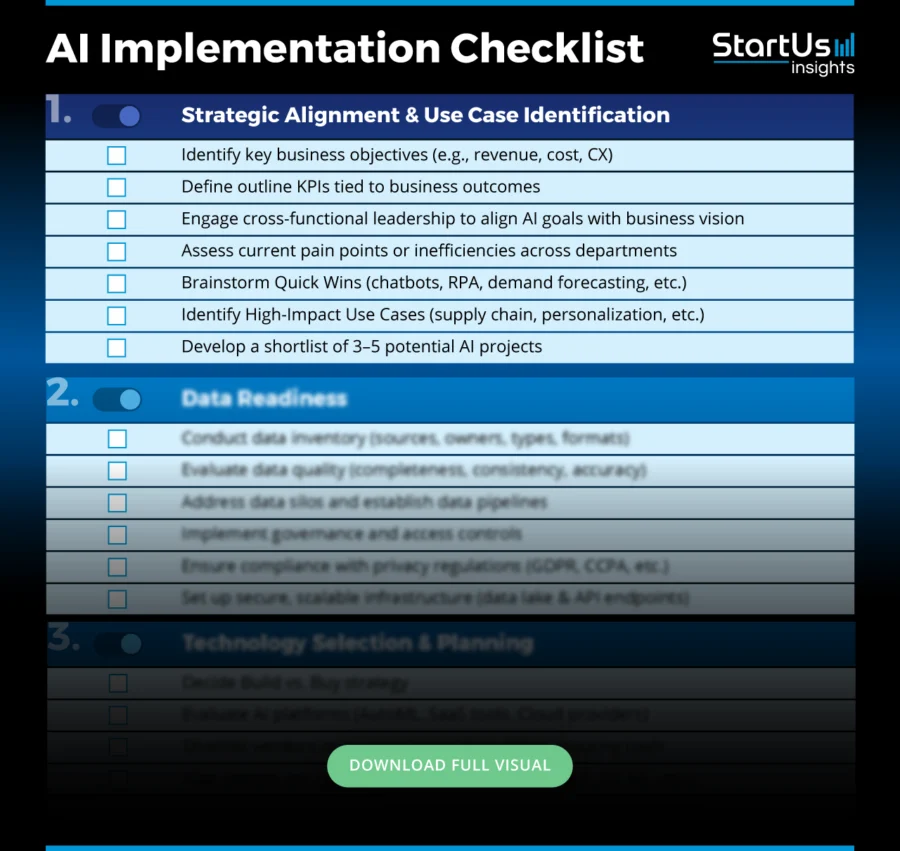
6. Asset Maintenance
Construction companies integrate AI-driven predictive maintenance to analyze data from sensors to anticipate equipment failures. Machine learning algorithms detect patterns in equipment behavior to extend asset lifespan by enabling proactive interventions.
From acquisition through maintenance to decommissioning, AI provides a comprehensive view of asset operations. This allows companies to identify optimal times for equipment replacement or refurbishment.
AI-powered digital twins allow real-time monitoring and predictive maintenance for structures, like bridges and buildings. They continuously assess structural integrity to facilitate timely interventions and reduce lifecycle costs.
AI-driven robots also inspect and maintain critical infrastructure. For example, Gecko Robotics robots detect structural damage in power plants and other facilities for quicker repairs.
Key Benefits
- Predictive Maintenance: AI analyzes sensor data from machinery and building systems to detect anomalies and predict failures before they occur.
- Improved Equipment Reliability: Machine learning models monitor wear patterns, usage frequency, and operating conditions to identify anomalies.
- Optimized Maintenance Scheduling: AI automates maintenance planning by factoring in equipment usage, workload, and historical service data to generate efficient schedules.
Popular Companies and Tools
MaintWiz Technologies
MaintWiz’s AI-driven asset management platform for construction and infrastructure projects enables real-time monitoring of equipment health, facility conditions, and operational workflows.
Its predictive maintenance capabilities leverage IoT data and machine learning to forecast failures, schedule repairs, and optimize asset lifecycle costs. MaintWiz also centralizes site data and automates maintenance decisions to reduce unplanned downtime.
Spotlighting an Innovator: Cognecto
Cognecto is an Indian company that builds AI-powered construction asset management solutions to optimize connected operations for heavy equipment. The company’s platform combines sensors, AI-driven analytics, and cloud-native architecture to provide real-time insights into equipment performance, usage patterns, and maintenance needs.
The platform’s features include real-time equipment tracking, predictive maintenance scheduling, fuel consumption monitoring, and dynamic resource allocation. By converting disconnected workflows into unified processes, Cognecto enhances operational efficiency, reduces downtime, and promotes sustainable growth.
7. Building Information Modeling
Artificial intelligence and machine learning streamline the design process by automating the creation of complex shapes during the conceptual phase to eliminate immediate BIM classification.
Clash detection is critical in construction planning as it identifies conflicts between building systems before construction starts. AI algorithms analyze BIM models to detect clashes efficiently and significantly reduce errors in sites.
AI-powered tools also evaluate building codes, industry standards, and project-specific guidelines using rule-based detection techniques. By examining digital models, teams proactively identify and resolve potential issues before they escalate into costly construction errors.
The synergy between AI and BIM enables dynamic digital replicas of physical assets and supports structural health monitoring, ergonomic risk assessments, and predictive maintenance. This integration optimizes energy use and carbon performance in structures.
Key Benefits
- Generative Design: AI-driven generative design within BIM platforms explores thousands of design permutations based on goals like cost, structural integrity, and sustainability.
- Optimized Resource Allocation: AI analyzes BIM data to forecast material needs, labor demand, and equipment utilization across project phases.
- Improved Design Efficiency: By automating clash detection, design validation, and code compliance checks, AI enhances BIM workflows and minimizes manual rework.
Popular Companies and Tools
ALLPLAN’s AI-powered BIM software
ALLPLAN offers AI-powered visualization tools, automated design features, and real-time collaboration capabilities to address labor shortages and rising costs.
The offerings include features like AI Visualizer for rapid architectural visualizations, a ceiling system tool for efficient suspended ceiling modeling, and enhanced multilayer slab functionalities. Additionally, the software offers automated reinforcement placement and improved support for curved beams through its AutoConverter service.
Spotlighting an Innovator: SmartScapes Studio
SmartScapes Studio is a Spanish startup that develops an AI-powered building design platform for residential developments. It utilizes generative AI to produce optimized architectural designs in real time, based on user-defined criteria.
Users input design parameters, like room dimensions, building heights, and vertical communication specifications, and the system generates corresponding 2D and 3D models. The platform also includes real-time BIM model generation, instant floor area calculations, and continuous compliance monitoring with urban regulations.
8. Sustainability and Energy Efficiency
AI facilitates the creation of energy-efficient building designs by analyzing factors such as orientation, window placement, insulation, and material performance. This allows architects to maximize natural light and ventilation.
Additionally, AI forecasts the performance of new sustainable materials like low-carbon concrete. This way, AI-driven systems reduce energy consumption and carbon emissions in buildings by approximately 8% to 19% by 2050.
AI-powered energy management systems also lower building operational costs by up to 20%. These systems optimize energy use by analyzing equipment performance, occupancy patterns, and building operations. Moreover, AI optimizes resource utilization during construction to minimize waste and enhance efficiency.
Key Benefits
- Enhanced Building Design: AI optimizes architectural models for energy performance by simulating thermal behavior, daylight use, and material impact.
- Renewable Energy Integration: AI algorithms assess site-specific variables, like sunlight exposure, wind flow, and load patterns, to recommend optimal placement and sizing of solar panels or wind systems. This ensures maximum renewable energy utilization and reduces long-term operating costs.
- Construction Waste Reduction: Machine learning models forecast material needs with high precision to minimize over-ordering and on-site waste.
Popular Companies and Tools
Stem
Stem leverages AI to optimize energy consumption and storage for construction sites and buildings through intelligent energy management. Its Athena platform utilizes real-time data and predictive analytics to automate battery storage usage that reduces peak demand charges and integrates renewable energy sources. This way, Stem aligns energy use with grid conditions and projects to support decarbonization goals.
Spotlighting an Innovator: Cove
Cove is a US-based company that provides AI-powered solutions for sustainable architecture. The company’s platform utilizes AI-driven algorithms to analyze extensive datasets that enable architects to optimize material usage, energy efficiency, and compliance.
Additionally, the platform supports energy analysis, embodied carbon assessments, and compliance reporting. Architectural firms utilize Cove’s platform to automate complex tasks and achieve sustainability objectives.
9. Supply Chain Management
Construction firms leverage AI for precise material demand forecasting. This enables companies to optimize inventory levels and reduce shortages and excesses. For instance, Prologis implemented AI-driven software to predict order volumes and optimize inventory needs while improving delivery times.
Companies also utilize AI to evaluate suppliers based on product quality, reliability, and delivery performance. By continuously assessing supplier performance, AI assists construction companies in making informed decisions on which suppliers to engage with.
Ducab, for example, automates pre-screening and self-registration of suppliers while tracking performance metrics, like delivery timeliness, using an AI-powered supplier portal.
AI systems enable real-time supply chain monitoring to detect anomalies and monitor storage conditions in warehouses. Additionally, AI simulates various “what-if” scenarios for companies to prepare for potential threats, such as the impact of a key supplier’s shutdown, and propose alternative solutions to mitigate risks.
Key Benefits
- Accurate Demand Forecasting: The algorithm analyzes historical data, project timelines, and market trends to accurately predict material and equipment needs.
- Optimized Inventory Management: AI-driven systems monitor inventory levels in real time and adjust replenishment schedules based on consumption patterns and project progress.
- Automated Procurement: AI automates supplier selection, bid comparisons, and order processing to streamline procurement workflows.
Popular Companies and Tools
Kaya AI
Kaya AI’s supply chain intelligence platform applies artificial intelligence to streamline sourcing, logistics, and procurement for large-scale construction projects. Designed for data centers and mission-critical infrastructure, the platform analyzes supplier performance, lead times, and material availability to anticipate disruptions and optimize procurement strategies.
Spotlighting an Innovator: Soil Link
Soil Link is a UK-based startup that builds an AI-powered materials exchange platform (MEP). The platform utilizes machine learning algorithms to efficiently connect parties with surplus materials to those in need and optimize matches.
Its cloud-based interface manages internal projects to facilitate material imports and exports, and enables secure, collaborative access for team members. This way, Soil Link promotes the reuse and recycling of soils to enhance sustainability and reduce waste.
10. Documentation and Communication
AI-powered tools streamline the processing of construction documents, like blueprints, contracts, and specifications, by leveraging computer vision and natural language processing (NLP).
TwinKnowledge, for example, collaborated with AWS to develop a solution combining large language models (LLMs) and computer vision to process thousands of architectural drawings.
AI also enhances team communication by providing real-time updates and facilitating rapid information sharing. AI-driven platforms deliver instant notifications on schedule changes, task completions, or safety alerts. This reduces miscommunication-related delays by up to 30%.
NLP-driven solutions simplify access to large datasets by allowing users to retrieve specific information through natural language queries. For instance, Turner Construction utilizes AI to analyze historical contracts and project data for improved risk prediction.
Additionally, AI-powered platforms automate contract analysis to boost compliance monitoring and enhance change-order management. Docugami extracts cost-related data from contracts for contractors to effectively track budgets and prevent cost overruns.
Key Benefits
- Efficient Permit Processing: AI accelerates permit approvals by auto-filling forms, validating compliance, and flagging missing data using NLP and rule-based engines.
- Enhanced Communication: AI-powered chatbots and virtual assistants streamline internal and external communications by providing instant responses, updates, and task reminders. This reduces email backlogs and improves coordination.
- Automated Document Management: Artificial intelligence tools categorize, tag, and retrieve project documents using intelligent search and metadata recognition.
Popular Companies and Tools
BBMP’s AI
The Bruhat Bengaluru Mahanagara Palike (BBMP) is implementing AI to automate the issuance of property documents and detect unauthorized constructions across the city.
By digitizing property records and using image recognition to compare approved plans with satellite imagery, the system accelerates document processing while enhancing transparency and compliance. This initiative streamlines municipal communication and documentation workflows in urban construction oversight.
Beck Technology’s AI-Powered DESTINI Estimator
Beck Technology has integrated AI into its DESTINI Estimator by acquiring Workpack. The AI engine automates document generation, tracks cost assumptions, and flags inconsistencies in real time. This improves clarity between stakeholders and reduces manual effort in producing bid packages, scope sheets, and design narratives.
Spotlighting an Innovator: Volve
Volve is a Norwegian startup that develops an AI-powered document evaluation platform for construction companies. Its solution automates the analysis of complex documents like requests for proposals (RFP), bids, and contracts, and highlights key sections by extracting pertinent information.
The platform features AI-powered document analysis, visual insights and comparisons, and an interactive chatbot for document exploration. This enables professionals to make well-informed decisions while minimizing risks.

Key Drivers Leading to the Adoption of AI in the Construction Industry
1. Efficiency and Productivity Gains
Automation of routine tasks is one of the key reasons for the increasing adoption of AI. Automating data analysis, scheduling, and monitoring allows construction companies to optimize project schedules and set more realistic timelines.
AI offers real-time data analytics that enables managers to make informed decisions and optimize resource allocations. By centralizing project data, these intelligent tools analyze vast amounts of information, predict risks, and optimize workflows. In a recent study, 92% of construction companies said they were already using or intend to use AI.
For example, Autodesk’s generative design technology creates multiple design options for structures based on predefined goals and constraints to enhance efficiency in the design phase.
2. Safety Enhancements
AI-powered sensors and cameras monitor safety compliance and detect potential hazards to reduce accidents and improve site safety. In 2022, the need for AI-driven safety measures was highlighted by a grim fatality rate of 9.6 per 100 000 full-time workers in the construction industry.
AI predicts maintenance needs to ensure equipment remains operational and reduce safety risks. This proactive approach prevents accidents by identifying and mitigating potential hazards before they occur.
Bouygues improved site safety by integrating AI into their safety management systems, which reduced accident rates by 22%.
3. Cost Savings and Sustainability
AI systems predict exact material needs and optimize material usage to reduce waste and costs. AI-enabled material optimization thus reduces material waste by up to 30%.
AI also prevents cost overruns by analyzing historical data to create predictive budget models. This approach makes mega-construction projects more cost-effective.
Deyaar Development’s Mar Casa project achieved a 57% reduction in the turnaround time for engineering submittals by using AI-powered construction management software.
Future of AI in the Construction Industry: 4 Emerging Trends
AI-Generated Design-to-Build Workflows
AI systems are evolving to generate full architectural and construction workflows, automatically accounting for zoning laws, material availability, environmental impact, and stakeholder preferences.
Why it matters: This drastically reduces the time and effort needed for planning and design iterations.
Benefits: Shorter project planning cycles, lower design costs, and reduced design errors through instant compliance checks and data-driven recommendations.
Robotic Swarms for Autonomous Construction
Swarms of AI-coordinated robots will collaborate to handle tasks like excavation, material handling, and modular assembly directly on site.
Why it matters: These autonomous systems improve safety and operational speed, especially in high-risk or remote areas.
Benefits: Fewer accidents, reduced labor shortages, faster build times, and round-the-clock site activity.
Generative AI for Real-Time Problem Solving
Construction platforms will embed generative AI that analyzes 3D scans, drone imagery, and sensor data to detect issues and recommend solutions on the fly.
Why it matters: This enables dynamic project management with immediate feedback and adjustments.
Benefits: Fewer delays, reduced rework, optimized schedules, and faster site decisions.
Self-Learning Digital Twins
AI-powered digital twins of buildings and job sites will be continuously updated using real-world data to reflect as-built conditions and usage patterns.
Why it matters: Construction firms will gain a living model of assets to simulate scenarios and plan long-term operations.
Benefits: Better maintenance planning, reduced lifecycle costs, improved asset performance, and stronger handover documentation.
Finding the Best AI Solutions for Your Construction Business
With thousands of emerging AI technologies and startups, navigating the right investment and partnership opportunities is challenging.
With access to 7M+ emerging companies and 20K+ technologies & trends globally, our AI and Big Data-powered Discovery Platform equips you with the actionable insights you need to stay ahead of the curve.
Leverage this powerful tool to spot the next big thing in AI before it goes mainstream. Stay relevant, resilient, and ready for what is next.

![AI in Construction: A Strategic Guide for Industry Leaders [2025-2030]](https://www.startus-insights.com/wp-content/uploads/2025/04/AI-in-Construction-SharedImg-StartUs-Insights-noresize-420x236.webp)

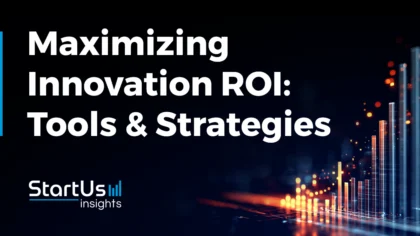
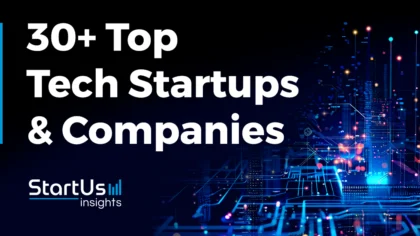
![Top 16 Future Technologies & How They Impact 40+ Industries [2026-2030]](https://www.startus-insights.com/wp-content/uploads/2024/06/Future-Technologies-SharedImg-StartUs-Insights-noresize-420x236.webp)

